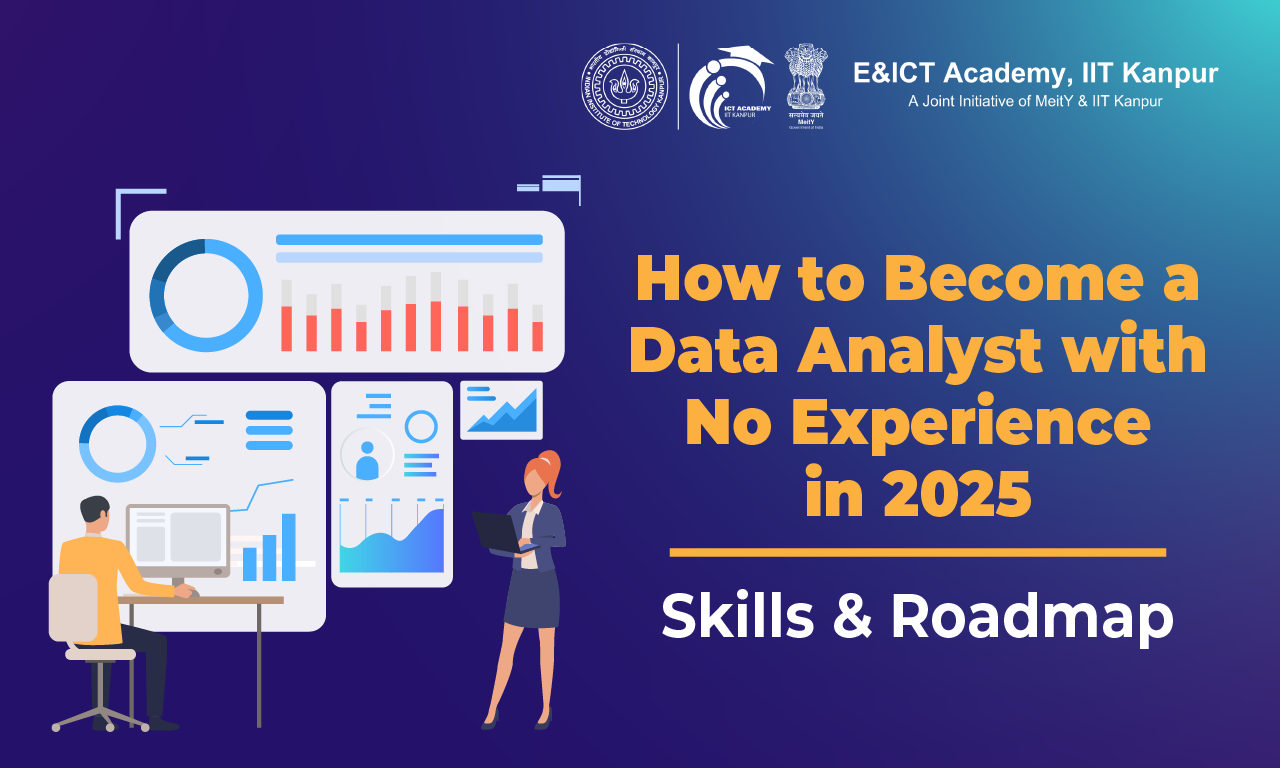How to Become a Data Analyst with No Experience in 2025: Skills & Roadmap

How to Become a Data Analyst with No Experience: Today, data analysts are in high demand because many companies use data to make their business decisions easier.
If you want to become a data analyst with no experience, no worries! You can begin a career as a data analyst with proper skills and knowledge.
This guide offers a step-by-step process to become a successful data analyst in 2025. It will also assist you in learning key skills, where to learn, how to practice with real data, and how to get jobs.
Also Read: How to Become Data Analyst in 2025?
What is Data Analytics?
The field of data analytics involves the analysis and research of large datasets in order to recognize patterns, trends, or insights. By doing data analysis, organizations are better able to make informed decisions, become more efficient, predict future outcomes, and make better problem solutions.
Data Analyst Prerequisites
It is very crucial to know the skills and knowledge needed for expertise in data analysis. Having a clear knowledge of data analyst skills is the basis to start your career. Without these fundamentals, it would be difficult to interpret and analyze data. No matter whether you are trying to analyze some trends, build models, or visualize data, these technical and soft skills act as a foundation for your success.
Technical Skills
- Programming Languages: Python and R assist in dealing with data and discovering patterns. SQL assists in retrieving data from databases. They assist in interpreting big data.
- Data Visualization Tools: Tableau and Power BI assist in producing charts and graphs that simplify data. These tools assist in making improved decisions.
- Excel & Spreadsheets: Excel makes it easy to organize and analyze data. Tools such as pivot tables and formulas simplify working with numbers.
- Statistics & Math: Understanding probability, trying out ideas with data, and analyzing trends make it easier to make intelligent predictions.
- Database Management: Organizing data makes it simple to locate and utilize. This facilitates quicker and improved analysis.
Soft Skills
- Thinking & Problem-Solving: A data analyst examines data, identifies patterns, and resolves problems based on information.
- Talking About Data: Making data simple for others to understand is important, so they can make wise decisions.
- Attention to Detail: Small errors in data can make wrong decisions. Care and precision are a must.
Must Read: What is Predictive Analytics
Step-by-Step Guide to Become a Data Analyst in 2025
Data Analytics has huge career opportunities. Following is a step-by-step tutorial to start your data analyst journey:
Step 1: Master the Fundamentals of Data Analytics
Before moving to data analysis technical skills, you need to know the fundamentals of data analytics. The majority of organizations apply data to make decisions more effectively, improve efficiency, and impact customer behavior. You may start with free online tools such as blogs, YouTube lessons, and starter courses to familiarize yourself with the basics of data analytics ideas.
Step 2: Enroll in a Data Analyst Course
A formal course has the capability to transfer systematic knowledge and skill, and it is easy to learn such complex topics. IIT Kanpur offers industry-specific data analytics courses to keep students updated with relevant skills. Learning in a certified course ensures that you will have insight into managing data, analytic techniques, and visualization tools.
Step 3: Gain Hands-on Experience with Real Datasets
Real-life experience is critical in data analytics. You may use actual real-world datasets on platforms like Kaggle, GitHub, or even government open-data stores. They help you improve data cleaning, statistical analysis, and visualization skills to develop strong analytical thinking.
Step 4: Mastering Key Tools and Technologies
Being a good data analyst requires that you be competent in several tools and technologies, such as:
- SQL – Inevitable when querying and administrating databases.
- Python & R – Statistical analysis and machine learning tools of choice.
- Tableau & Power BI – Necessities in creating interactive visualizations and dashboards.
- Excel & Google Sheets – Helpful tools for data manipulation, formulas, pivot tables, and collaborative data processing.
Learning these applications will go a long way to enhance your handling and reporting of data.
Step 5: Have a Strong Portfolio
Employers look for candidates with hands-on experience, so building a strong portfolio is very important. Your portfolio should showcase your expertise in:
- Customer behavior analysis to identify trends.
- Market trend predictions using statistical modeling.
- Interactive dashboards developed using Tableau or Power BI.
A well-made portfolio shows your ability to work with real data and attracts employers.
Step 6: Get Industry-Approved Certifications
Certifications show your skills and improve career opportunities. If you have been wondering, “What certification do I need to be a data analyst?”, consider:
- Google Data Analytics Certificate
- Microsoft Certified: Data Analyst Associate
- IBM Data Analyst Professional Certificate
These certifications make your resume stronger and also meet the important data analyst requirements for employers.
Step 7: Apply for Entry-Level Positions and Internships
After acquiring the required skills and a solid portfolio, begin applying for entry-level positions like:
- Junior Data Analyst
- Business Intelligence Analyst
- Data Entry Specialist
Employment portals such as LinkedIn, Indeed, and Glassdoor are some places to find suitable candidates. Making a connection with professionals within your sector of business and networking on data analytics platforms increase your chances of achieving success.
Step 8: Stay Up-to-Date with Industry Trends
Data analysis is a constantly developing area with the latest technologies and resources. It’s extremely important to stay updated by:
- Reading data science forums and industry blogs.
- Enroll in advanced courses to enhance your capabilities.
- Attending webinars and workshops to pick the brains of industry experts.
IIT Kanpur keeps revising its courses to align them with industry demands. Scouting out their newer courses can help you become job market competitive.
Frequently Asked Questions
1. What is required to be a data analyst?
Data Analyst must have Technical knowledge, analytical skills, certification, and field experience.
2. How do I get into data analyst?
Start with online courses, use actual datasets, and create a portfolio to showcase your analyst capabilities.
3. What certification do I need to be a data analyst?
Google Data Analytics Certificate, Microsoft Data Analyst Associate, and IBM Data Analyst Professional Certificate are strongly recommended certifications.
4. Is a data analyst an IT job?
Although data analysts collaborate with IT teams, the profession is more concerned with business insights and decision-making than IT infrastructure.
| Data Analyst Related Articles | |
|---|---|
| Best Data Analysis Course | Data Analysis Techniques |
| Data Analyst Skills | What is Predictive Analytics |
| Python Interview Questions | Excel Formula for Data Analytics |
Conclusion
It is possible to become a data analyst in 2025 if you take the proper steps. First, learn data basics. Then, enroll in a good course to develop your skills. Practice by doing actual projects, and get certificates to prove your knowledge. Continue learning and network with other experts to grow in this profession.
If you desire proper training, you can visit courses from IIT Kanpur. These courses can make you a wonderful data analyst. Begin your learning process today and establish a prosperous future in data analytics!



